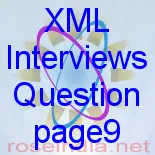XML Interviews Question page9
-
Can I encode mathematics using XML ?
A: Yes, if the document type you use provides for math, and your users' browsers are capable of rendering it. The mathematics-using community has developed the MathML Recommendation at the W3C, which is a native XML application suitable for embedding in other DTDs and Schemas. It is also possible to make XML fragments from other DTDs, such as ISO 12083 Math, or OpenMath, or one of your own making. Browsers which display math embedded in SGML existed for many years (eg DynaText, Panorama, Multidoc Pro), and mainstream browsers are now rendering MathML. David Carlisle has produced a set of stylesheets for rendering MathML in browsers. It is also possible to use XSLT to convert XML math markup to LATEX for print (PDF) rendering, or to use XSL:FO.
Please note that XML is not itself a programming language, so concepts such as arithmetic and if-statements (if-then-else logic) are not meaningful in XML documents.
-
How will XML affect my document links?
A: The linking abilities of XML systems are potentially much more powerful than those of HTML, so you'll be able to do much more with them. Existing href-style links will remain usable, but the new linking technology is based on the lessons learned in the development of other standards involving hypertext, such as TEI and HyTime, which let you manage bidirectional and multi-way links, as well as links to a whole element or span of text (within your own or other documents) rather than to a single point. These features have been available to SGML users for many years, so there is considerable experience and expertise available in using them. Currently only Mozilla Firefox implements XLink. The XML Linking Specification (XLink) and the XML Extended Pointer Specification (XPointer) documents contain the details. An XLink can be either a URI or a TEI-style Extended Pointer (XPointer), or both. A URI on its own is assumed to be a resource; if an XPointer follows it, it is assumed to be a sub-resource of that URI; an XPointer on its own is assumed to apply to the current document (all exactly as with HTML). The TEI Extended Pointer Notation (EPN) is much more powerful than the fragment address on the end of some URIs, as it allows you to specify the location of a link end using the structure of the document as well as (or in addition to) known, fixed points like IDs. For example, the linked second occurrence of the word ‘XPointer’ two paragraphs back could be referred to with the URI (shown here with linebreaks and spaces for clarity: in practice it would of course be all one long string):
http://xml.silmaril.ie/faq.xml#ID(hypertext)
.child(1,#element,'answer')
.child(2,#element,'para')
.child(1,#element,'link')
This means the first link element within the second paragraph within the answer in the element whose ID is hypertext (this question). Count the objects from the start of this question (which has the ID hypertext) in the XML source:
1. the first child object is the element containing the question ();
2. the second child object is the answer (the element);
3. within this element go to the second paragraph;
4. find the first link element.
Eve Maler explained the relationship of XLink and XPointer as follows:
XLink governs how you insert links into your XML document, where the link might point to anything (eg a GIF file); XPointer governs the fragment identifier that can go on a URL when you're linking to an XML document, from anywhere (eg from an HTML file).
[Or indeed from an XML file, a URI in a mail message, etc…Ed.] David Megginson has produced an xpointer function for Emacs/psgml which will deduce an XPointer for any location in an XML document. XML Spy has a similar function.
-
How does XML handle metadata?
A: Because XML lets you define your own markup languages, you can make full use of the extended hypertext features of XML (see the question on Links) to store or link to metadata in any format (eg using ISO 11179, as a Topic Maps Published Subject, with Dublin Core, Warwick Framework, or with Resource Description Framework (RDF), or even Platform for Internet Content Selection (PICS)).
There are no predefined elements in XML, because it is an architecture, not an application, so it is not part of XML's job to specify how or if authors should or should not implement metadata. You are therefore free to use any suitable method. Browser makers may also have their own architectural recommendations or methods to propose.



